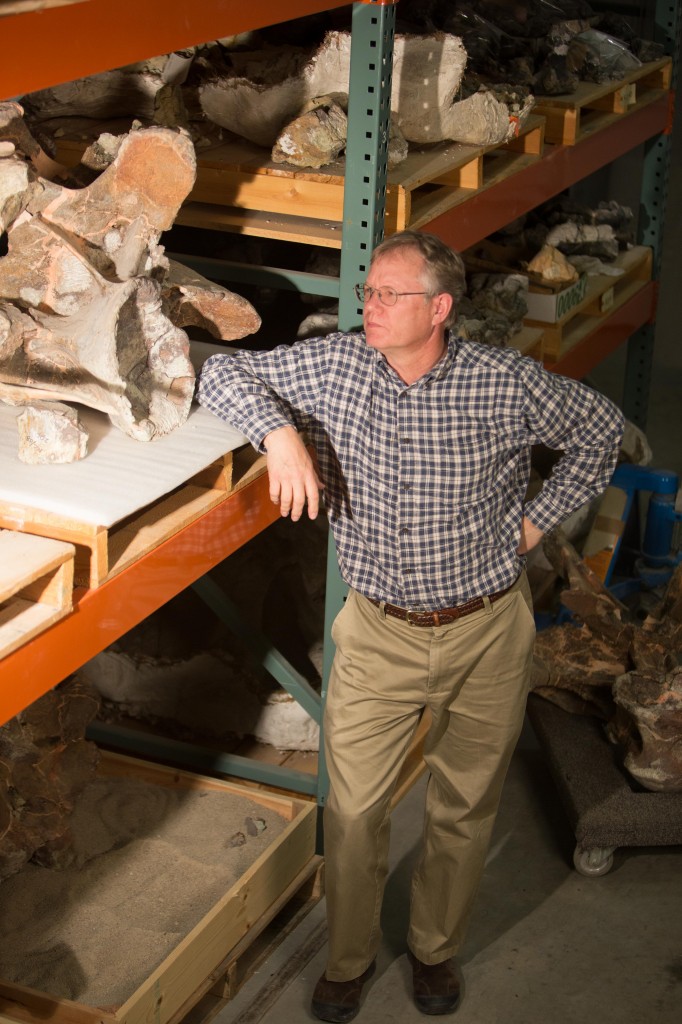Brooks Britt knew he wanted to be a scientist at a very young age. When he was 10 years old, a friend of his father’s gave him a collection of geological minerals, and he decided he wanted to be a geologist. At the age of 11, he focused

his love of geology on a more specific area of study — paleontology.
Shortly after he discovered his love of dinosaurs, Britt, now a BYU professor, began to search for fossils. He experienced a degree of success as a youth by finding fossils such as trilobites in many of the places he looked. At 14, he concluded he wanted to find an actual dinosaur skeleton, and the following summer he traveled from Seattle, Washington, to Ogden, Utah, to look for bones.
On the first day of his search Britt and his cousin rode their bikes about 10 miles north of Ogden to an area now known as Red Narrows. Once there, they scouted for fossils.
“As we walked up the ravine, we found little fragments of bone,” Britt said. “We started digging, and we found parts of an 87-foot dinosaur, Diplodocus. And then we found Allosaurus, and then a Dryosaur and other sundry things.”
The excavation lasted for a total of three summers. Each day Britt and his cousin rode their bikes down to the excavation site to dig up more pieces of the bones. They uncovered the dinosaurs piece by piece and wrapped each one individually in plaster and burlap jackets to prevent them from breaking during transport. The duo transported these heavy bones in their backpacks by bicycle or city bus for two of the three summers until Britt got his driver’s license and access to a car.
According to Britt, this experience truly fostered his love for paleontology.
“That was the beginning,” Britt said. “My cousin became a paleontologist and got his Ph.D, and I became a paleontologist too. It was great.”
Shortly after completing their excavation, Britt and his cousin contacted local authorities to have them inspect their findings for potential housing in a state museum. The officials inspected the fossils but were unable to take them due to a lack of funding and the sheer size of the bones. Instead, Britt utilized a local high school chemistry lab to extract the fossils from the enclosed rock. He eventually came in contact with renowned paleontologist and BYU professor Jim Jensen who gladly accepted the bones.
Britt went on to study geology at BYU, eventually receiving both his bachelor’s and master’s degrees. He later completed his doctorate at the University of Calgary. After working in a couple different museums, he eventually landed back in Provo and became a professor at BYU, where he remains to this day, teaching and helping with the Museum of Paleontology.
Museum assistant and geology student Mariah Chambers has worked with Britt directly at the museum and has learned a lot from him.
“My favorite thing about Dr. Britt is that he is, first and foremost, a mentor no matter what he is doing,” Chambers said. “He cares about individual students and, in his own way, will help them learn the things that will help them most.”
Students have taken Britt’s classes and have been inspired by his passion for not only dinosaurs and geology but for life in general. During class, he often stresses the importance of seeing with “new eyes,” meaning that there is beauty to be seen in all aspects of life, if people look for it.
Colin Lindsey, a junior in the wildlife conservation program, has learned to see with those “new eyes.”
“(Before this class) I had never appreciated before how fascinating ancient life can be,” Lindsey said. “(A lot) can be learned from the earth and how science can still function with long-extinct organisms.”
Britt is also known for his engaging style of teaching and for his sense of humor, often making students laugh.
“He’s fun and likes to joke around,” said Aaron Holmes, a grad student in the geology program and Britt’s personal TA. “I also notice that although he likes to tease and mess around with people, he genuinely cares about them and is not afraid to tell you when you need to be set straight.”
Britt has been around the world and found remains of ancient life in many different places. He has found new species and named his own dinosaur, but what matters most to him is passing down a love for the ancient world and seeing it come full circle.
“There is nothing better than after someone has graduated and they come back saying, ‘Wow, I had my kids, and we were driving through a canyon, and I told them about the ancient world and what it represents,'” Britt said. “That is what makes it all worthwhile.”




